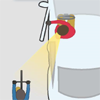THE DUTCH FAR HAND METHOD - A BRIEF SUMMARY
The Dutch learned decades ago to train drivers & passengers to avoid doorings and dooring-forced swerve crashes of cyclists by simply using their opposite hand - the far hand - to open when exiting.
Concisely stated:
Reach, Swivel, Look out at mirror, to side & back,
Open slowly. Exit facing traffic.
Advantages with the far hand vs the near:
- You can't fling open the door - whereas it is all too easy to push or fling wide with the near hand.
- It forces you to turn outward, to look at side-mirror and around to the side.
- Then you can easily look directly back for bicycles or other vehicles - a 'shoulder check'. Now slowly prop the door open and you gain a continuous unobstructed line-of-sight view back. When safe, open more fully to exit.
- Far hand on door, you exit facing on-coming traffic. With the near hand on the handle, drivers tend to exit facing forward instead. Hence it is safer for drivers & passengers as well.
- Once an ingrained habit, the Reach is an automatic best practice.
This ‘opposite hand trick’ has other advantages as well: It overcomes the blind spots & transiency of mirror views; the initial door prop can alert on-coming cyclists to take defensive action more safely – yell, brake, signal or check before veering outward, thus less likely to lose control, crash or be struck secondarily; and it works for rear seated passengers lacking mirror access; far-hand retains control of door – pull-back or retreat from danger is easier.
Now as bicycle use and tragic doorings increase in cities around the globe, the Dutch Reach is gaining attention and official recognition and endorsement beyond continental Europe.
HISTORY & USE
The Dutch adopted the far hand method about 50 years ago. It was a time of extreme road carnage in Holland, which resulted in a grieving mothers' protest movement called 'Stop the Child Murder ' (Stop de Kindermoord). Their demand led to vast reforms over the following decades, which madeThe Netherlands the road sharing mecca it is today. The far hand method became common practice, taught in driving school and used to pass the stringent road test for safe exiting of vehicles.
As a result, in Holland it came to be called, 'the way you open a car door.'
The Dutch considered it so obvious and ordinary that they seldom spoke of it. Over the years though, this commonsense but nameless method spread to Sweden, Denmark, and less so to parts of France, Germany & Belgium. Only in this decade did it began to be recognized in English and initially promoted in the US, Canada & Australia (but not the UK). Apparently, the first U.S. media account appeared in the New York Times, in 2011: “The Dutch Way...” http://www.nytimes.com/2011/07/31/opinion/sunday/the-dutch-way-bicycles-and-fresh-bread.html
Now San Francisco MTA teaches it as part of its Large Urban Vehicle Driver Safety Program & video (2015) [at min. 14:30]: https://www.youtube.com/watch?v=_LbC3FQeZqc as does Uber of San Francisco in its Road Sharing with Bicycles videos of 2016; https://www.youtube.com/watch?v=DlQXb5GbfCo. Fort Collins, CO calls it the "Opposite Hand Trick" as part of its Bicycle Friendly DriverProgram: http://www.fcgov.com/bicycling/bike-friendly-driver-program.php.
It has also has been promoted in Melbourne & VicRoads of Victoria, Australia in 2011; by the cities of Chicago, IL & New Haven, CT in 2013 (in the latter as the "Amsterdam Method"); in Montreal by Une Porte Une Vie in 2014, and earlier by activists in Toronto, Canada.
More recently, the City of Cambridge, MA teaches it in its 2016 citizen road sharing guide:
Cambridge Street Code - Rules & Etiquette for Getting There Together – “Doors are Dangerous”, (p.9)
http://www.cambridgema.gov/CDD/News/2016/12/~/media/9EC803500FCE4B2CACFCCA0FC4E93E4C.ashx
And the Royal Society for the Prevention of Accidents (UK) – the British equivalent of the National Safety Council (USA) -- endorsed the Dutch Reach as a road safety best practice in early 2017: https://www.rospa.com/road-safety/advice/pedal-cyclists/sharing-the-road-together-drivers-cyclists/dutch-reach/
The most prominent adoption of the far hand method however has recently occurred in the United States when the state of Massachusetts added the Reach to its 2017 Driver's Manual:
Commonwealth of Massachusetts’ Driver’s Manual, Press Release & Video:
2017 Comm. MA Driver's Manual, pdf, Chapter 4, Rules of the Road, p. 109:
https://www.massrmv.com/Portals/30/docs/dmanual/Drivers_Manual.pdf
MassDOT 'Dutch Reach' Press Release, 5/30/17:
http://www.massrmv.com/Portals/30/docs/dmanual/chapter_4.pdf
MassDOT Dutch Reach Video (2017):
https://www.youtube.com/watch?v=8A-9RGDFGDE
More information on the Dutch Reach may be found or downloaded from www.dutchreach.org where you may find videos, animations, graphics, suggestions & text to jump start local education, outreach and advocacy campaigns.
\ \ \ \ \ \ \ \ \ \/ / / / / / / / / /
DR ver. 7/2/17
Microsoft Word version of Briefing ver. 7/2/17 may be viewed by using scroll slider, and downloaded using the Icon at the bottom lower left of the document frame.
